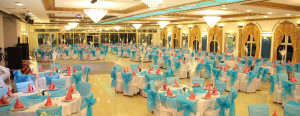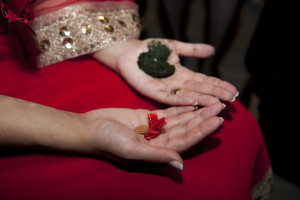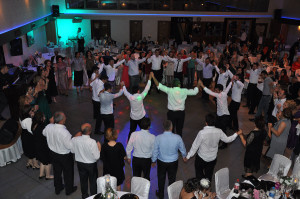Saying “I Do” Turkish Style – 10 Facts about Turkish weddings
0 Comment
 If you have ever been to a Turkish wedding you will know that they are a lively affair, and that even modern Turkish weddings have a traditional vibe and have a heap of customs and superstitions attached to them. A Turkish wedding can span over anywhere from three days to just one night. A rule of thumb is that the more rural the setting, the longer the wedding celebrations go for. Turkish wedding traditions, of course, vary across regions, however there is usually a common thread. Here are 10 facts about Turkish weddings:
If you have ever been to a Turkish wedding you will know that they are a lively affair, and that even modern Turkish weddings have a traditional vibe and have a heap of customs and superstitions attached to them. A Turkish wedding can span over anywhere from three days to just one night. A rule of thumb is that the more rural the setting, the longer the wedding celebrations go for. Turkish wedding traditions, of course, vary across regions, however there is usually a common thread. Here are 10 facts about Turkish weddings:
- The engagement – before the wedding the couple may participate in a Söz Kesimi. This is a “promise” or engagement ceremony where the couple agree to marry. Often held at home, the bridegroom’s family will bring a ring, an embroidered handkerchief and sweets. Both families give their consent to the wedding, then the ring and hanky are given to the bride and the sweets shared among all. This may be followed by a bigger engagement ceremony where friends and family of both couples get together to get to know each other. Turkish engagements are generally much shorter than western engagements.
- The invitations – in days gone by criers would go from neighbourhood to neighbourhood to invite everyone to a wedding. In some areas, small gifts would be distributed in place of invitations – this tradition is largely forgotten now, although it still occurs in some rural areas. These days usually a professionally printed invitation will be distributed to all and sundry just a short time before the big day. Turkish weddings are BIG – it is not unusual for 500 or more people to be invited. In small villages and towns in rural areas, quite often the whole village will get an invite to the big day.
- The ceremony – although religious wedding ceremonies are not legally recognised in Turkey, because it is a secular country, these are sometimes still carried out in addition to a legal ceremony. The legal ceremony is usually conducted at the local municipality wedding office. This will sometimes take place months before the actual wedding party.
 Forget the hen’s night – it’s all about the henna night! A night or two before the wedding the henna night, or (‘kina gecesi’) takes place. This was traditionally for women only, although these days it is increasingly common for both the bride and groom to attend. Female members of both families will gather at the bride’s family home, and a female elder will recite prayers. The bride, who will traditionally be dressed in red, and with a red veil will be seated in the centre of the room. Prayers will be recited, and emotional songs depicting mothers losing their daughters and motherhood are sung. The bride’s mother-in-law to be will then hold a cup of henna, and will try to put some on the bride’s palm. It is traditional for the bride to refuse until a gold coin is placed into her hand. After the bride’s palm has been covered in henna, other guests will do the same. This ceremony is followed by lively singing and dancing.
Forget the hen’s night – it’s all about the henna night! A night or two before the wedding the henna night, or (‘kina gecesi’) takes place. This was traditionally for women only, although these days it is increasingly common for both the bride and groom to attend. Female members of both families will gather at the bride’s family home, and a female elder will recite prayers. The bride, who will traditionally be dressed in red, and with a red veil will be seated in the centre of the room. Prayers will be recited, and emotional songs depicting mothers losing their daughters and motherhood are sung. The bride’s mother-in-law to be will then hold a cup of henna, and will try to put some on the bride’s palm. It is traditional for the bride to refuse until a gold coin is placed into her hand. After the bride’s palm has been covered in henna, other guests will do the same. This ceremony is followed by lively singing and dancing.- Gelin Alma – in some areas, the wedding day begins with a ceremony which roughly translates as “fetch, or get the bride”! This involves a procession either on foot or in cars where the groom’s family and friends travel to the bride’s house and collect her to take her to either the ceremony location or the groom’s house where the mother of the groom will present the bride with a gift. This is usually a colourful and noisy affair and everyone is in high spirits. Back in the day the bride was taken away on a horse, but these days it’s generally done by car. Often children (and even adults) will step in the way of the wedding procession, refusing to move until the wedding party gives them money in order to pass.
- The dress– these days most Turkish brides will wear a modern wedding gown, similar to those in western countries. If a bride chooses to cover her hair she will wear a gown with long sleeves, and a white lace head covering. It is a tradition for the bride to write the names of her single friends on the bottom of her wedding shoes in order to bring them luck in finding a husband.
 The venue can range from a garden to a ballroom. While in metropolitan areas the wedding party may be held in a restaurant, a wedding salon, or even a lavishly decorated ballroom, in rural areas the wedding party may be held at home in the garden or in the local school yard with minimal decorations.
The venue can range from a garden to a ballroom. While in metropolitan areas the wedding party may be held in a restaurant, a wedding salon, or even a lavishly decorated ballroom, in rural areas the wedding party may be held at home in the garden or in the local school yard with minimal decorations.- Food at a Turkish wedding may vary, depending on the time of day, the venue and the circumstances of the families. It may range from as little as some biscuits or pastries served with soft drinks, to an elaborate main meal. If a main meal is served the bridge and groom may not eat it with the guests. Some traditional wedding foods include Keşkek (a dish made of pounded wheat and meat), wedding soup, yogurt soup, saffron jelly, halvah, homemade baklava, stewed lamb, savoury pastries with meat, and sarma (stuffed grape leaves).
 Dancing – this will generally begin after the bride and groom have made a grand entrance to sparklers, often through a walkway or archway made by the wedding guests. The groom will then remove his bride’s veil and then they will have their first dance together. After the first song, other guests will join in, and then the party begins. The volume of the music will go up, and there may even be live music which will heavily feature drums. Music will often be traditional folk music, although some may also include western music.
Dancing – this will generally begin after the bride and groom have made a grand entrance to sparklers, often through a walkway or archway made by the wedding guests. The groom will then remove his bride’s veil and then they will have their first dance together. After the first song, other guests will join in, and then the party begins. The volume of the music will go up, and there may even be live music which will heavily feature drums. Music will often be traditional folk music, although some may also include western music.- Gifts – later in the night the bride and groom may take a break from celebrations and they will stand wearing sashes, onto which guests will pin money or a gold coin instead of giving presents.
